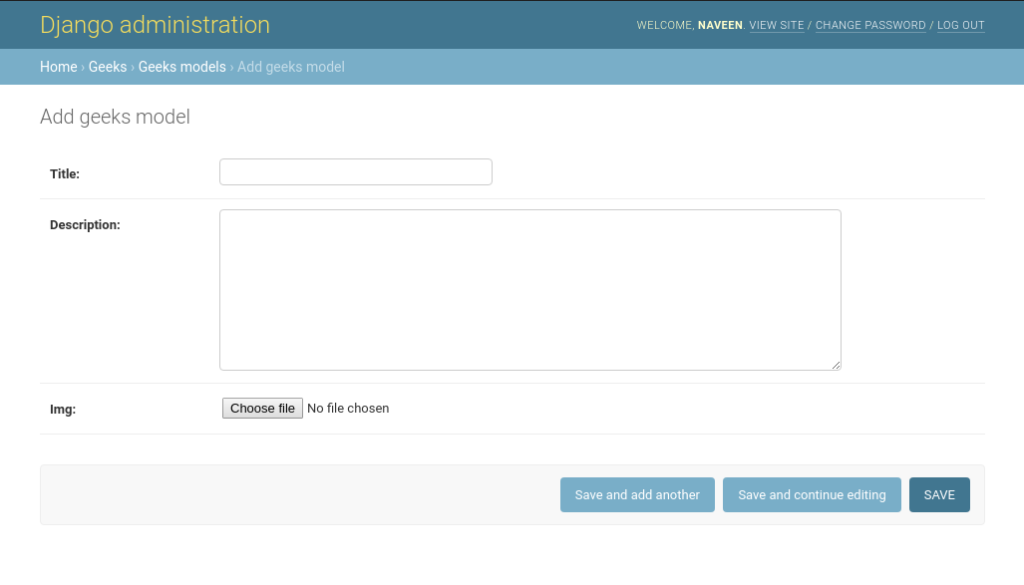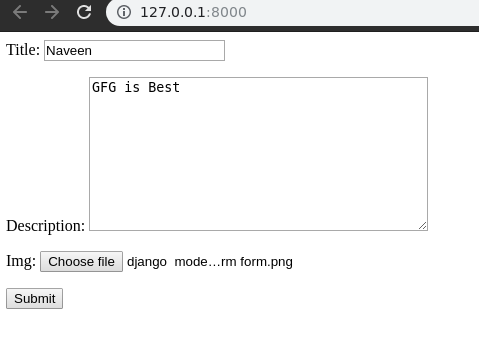Django ModelForm Create form from Models (original) (raw)
Last Updated : 16 May, 2022
Django ModelForm is a class that is used to directly convert a model into a Django form. If you’re building a database-driven app, chances are you’ll have forms that map closely to Django models. For example, a User Registration model and form would have the same quality and quantity of model fields and form fields. So instead of creating a redundant code to first create a form and then map it to the model in a view, we can directly use ModelForm. It takes as an argument the name of the model and converts it into a Django Form. Not only this, ModelForm offers a lot of methods and features which automate the entire process and help remove code redundancy.
How to convert a model into a Django Form?
To explain the working of the project, we will use project geeksforgeeks, create a model and map it to Django forms.
Refer to the following articles to check how to create a project and an app in Django.
Now when we have our project ready, create a model in geeks/models.py,
Python3
from django.db import models
class GeeksModel(models.Model):
`` title = models.CharField(max_length = 200 )
`` description = models.TextField()
`` last_modified = models.DateTimeField(auto_now_add = True )
`` img = models.ImageField(upload_to = "images / ")
`` def __str__( self ):
`` return self .title
Before we create a model let’s register our app in the main project. Go to geeksforgeeks/settings.py file and add geeks app in INSTALLED_APPS list. If we make migrations before this step it will display a message saying there are no changes made.
Now, run following commands to create the model,
Python manage.py makemigrations Python manage.py migrate
We can check that model has been successfully created at http://127.0.0.1:8000/admin/geeks/geeksmodel/add/,  To create a form directly for this model, dive into geeks/forms.py and Enter following code,
To create a form directly for this model, dive into geeks/forms.py and Enter following code,
Python3
from django import forms
from .models import GeeksModel
class GeeksForm(forms.ModelForm):
`` class Meta:
`` model = GeeksModel
`` fields = "__all__"
This form takes two arguments fields or exclude.
- fields – It is strongly recommended that you explicitly set all fields that should be edited in the form using the fields attribute. Failure to do so can easily lead to security problems when a form unexpectedly allows a user to set certain fields, especially when new fields are added to a model. Depending on how the form is rendered, the problem may not even be visible on the web page. Set the fields attribute to the special value ‘__all__’ to indicate that all fields in the model should be used.
- exclude – Set the exclude attribute of the ModelForm’s inner Meta class to a list of fields to be excluded from the form. For example:
class PartialAuthorForm(ModelForm): class Meta: model = Author exclude = ['title']
Finally, to complete our MVT structure, create a view that would render the form and directly save it to the database. In geeks/views.py,
Python3
from django.shortcuts import render
from .forms import GeeksForm
def home_view(request):
`` context = {}
`` form = GeeksForm(request.POST or None , request.FILES or None )
`` if form.is_valid():
`` form.save()
`` context[ 'form' ] = form
`` return render(request, "home.html", context)

Everything is set, Now visit http://127.0.0.1:8000/, Now you can see that every model field is mapped into a form field and displayed correspondingly. Field mappings are discussed later in this article. So now let’s try entering data into the form and check if it gets saved into the database.

Hit submit and Bingo the form gets saved automatically to database. We can verify it at http://localhost:8000/admin/geeks/geeksmodel/. 
Field types
The generated Form class will have a form field for every model field specified, in the order specified in the fields attribute. Each model field has a corresponding default form field. For example, a CharField on a model is represented as a CharField on a form. A model ManyToManyField is represented as a MultipleChoiceField. Here is the full list of conversions:
| Model Field | Form Field |
|---|---|
| AutoField | Not represented in the form |
| BigAutoField | Not represented in the form |
| BigIntegerField | IntegerField with min_value set to -9223372036854775808 and max_value set to 9223372036854775807. |
| BinaryField | CharField, if editable is set to True on the model field, otherwise not represented in the form. |
| BooleanField | BooleanField, or NullBooleanField if null=True. |
| CharField | CharField with max_length set to the model field’s max_length and empty_value set to None if null=True. |
| DateField | DateField |
| DateTimeField | DateTimeField |
| DecimalField | DecimalField |
| DurationField | DurationField |
| EmailField | EmailField |
| FileField | FileField |
| FilePathField | FilePathField |
| FloatField | FloatField |
| ForeignKey | ModelChoiceField |
| ImageField | ImageField |
| IntegerField | IntegerField |
| IPAddressField | IPAddressField |
| GenericIPAddressField | GenericIPAddressField |
| ManyToManyField | ModelMultipleChoiceField |
| NullBooleanField | NullBooleanField |
| PositiveIntegerField | IntegerField |
| PositiveSmallIntegerField | IntegerField |
| SlugField | SlugField |
| SmallAutoField | Not represented in the form |
| TextField | CharField with widget=forms.Textarea |
| TimeField | TimeField |
| URLField | URLField |